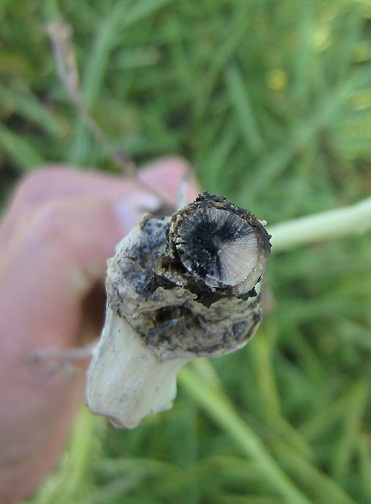Canola Production and Management
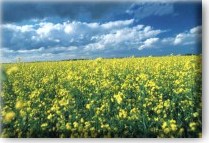 | |
Field SelectionCanola and/or rapeseed are cool season crops and yield highest when grown in moderate agricultural climates, where extreme heat and moisture are not usual. As well, growing other crops susceptible to sclerotinia (stem rot) too frequently in the rotation, can increase the risk of stem rot in canola and reduce yields. | |
Variety InformationChoose varieties to match the conditions in your area and on your field. Variety characteristics to consider are:
Seed Manitoba Variety Selection & Growers Guide Variety performance, acreage, seeding date and crop rotation have effects on yield. Manitoba Management Plus Program by Manitoba Agricultural Services Corporation (MASC) | |
Seeding Canola
Article: Use Caution When Considering Alternate Seeding Methods of Canola
Treatments
Canola seed is usually treated with both a fungicide and insecticide. The fungicide minimizes seedling losses to damping off, root rot and seed-borne blackleg. The insecticide seed coating is for very early flea beetle control. When flea beetles are expected to be a serious problem, an additional foliar insecticide application may need to be considered to extend the duration of flea beetle control past three to four weeks after emergence. For recommendations, consult the Guide to Field Crop Protection.
Recommended Dates
- Argentine canola: May 1 to June 10 - see MASC for seeding date requirements in different areas
- Polish canola: May 1 to June 20
Rates
Final plant stands of seven to eleven plants/ft2 or 70 to 110 plants/m2 are ideal. Seeding rates should be based on the seed size (thousand seed weight), desired plant stand and environmental conditions at the time of seeding. Seeding rates on the high end of the recommended range should be used when seeding is late, soil is prone to crusting, conditions are cool or there is heavy weed pressure. When emergence problems occur, thin plant stands usually provide a better crop than would a reseeded crop.
Seeding Depth
0.5 to 1.5 inches. Seed should be placed only deep enough to reach moisture. If soil is dry down to two-inch depth, seed shallow and wait for rain.
Fertilizer Recommendations For Canola
General
For specific recommendations on fertilizer rates, have your soil tested. Canola is sensitive to high rates of seed-placed fertilizer. All potassium and sulphur should be applied away from the seed. If soil analysis is not available, a general recommendation is as follows:
| Nitrogen (N): | Apply 0-30 lb/acre N following fallow or legume breaking, 30-70 lb/acre N following grass and grass-legume breaking and 70-90 lb/acre N following stubble. High-yielding canola requires high nitrogen fertility, but excessive nitrogen has been linked to green seed problems and delayed maturity. Nitrogen deficiency symptoms are yellowing, starting with the older leaves, and thin, spindly stems. |
| Phosphate (P2O5): | Apply phosphate rates at 30-40 lb/acre as a sideband or 20 lb/acre with the seed. Phosphate deficiency symptom is poor root development and reduced branching with thin, spindly branches. |
| Potassium (K2O): | On sandy textured or organic soils, apply potassium at rates of 30-60 lb/acre. Potassium deficiency symptoms are stunted growth with smaller leaves and thinner stems. Leaf edges of lower leaves turn brown and drop off. |
| Sulphur (S): | Apply sulphate sulphur at 20 lb/acre. A soil test is recommended to establish the available sulphur status of fields. Application of fertilizer in a N:S ratio of 5:1 will usually supply adequate sulphur. Elemental sulphur must be applied one year before the canola crop to allow time for conversion to sulphate. A minor sulphur deficiency may not be detected visually but results in significant yield reductions. Major sulphur deficiency symptoms are visible on the newest leaves and start with yellowing. Severe deficiencies will show up as cupping, purpling of leaves. |
Weed Control
After canola forms a canopy, it is very competitive vs. weeds. Optimal timing of weed control for is at the 2 - 4 leaf stage. Under heavy weed pressure or with hard to control weeds, two herbicide applications may be needed.
Weed seeds that are difficult to remove or cannot be cleaned out of canola and cause downgrading are wild mustard, oriental mustard, brown mustard, ball mustard, cow cockle and cleavers. If canola is going into a field known to be very weedy, select the herbicide tolerance carefully for products that will be able to effectively control the weed spectrum.
Link:
Insects
Grasshoppers, cutworms, bertha armyworm, flea beetles, diamondback moths, lygus bugs, and root maggots can damage canola. The insects that are currently monitored are bertha armyworm and diamondback moth. Links: |
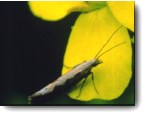 Diamondback moths 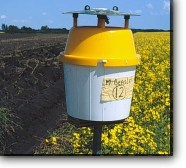 Bertha armyworm pheromone trap |
Diseases Affecting CanolaCanola is highly susceptible to sclerotinia, and therefore crop rotations that include field beans, field peas, mustard, sunflowers and other sclerotinia-susceptible crops increase the risk of infection on the canola crop. In canola, several fungicide treatments are available for control of sclerotinia. Other major diseases that affect canola are blackleg, alternaria black spot and clubroot. Varieties tolerant to blackleg and/or clubroot are available and should be grown in all parts of Manitoba to minimize the impact of these diseasee. Links: |
Basal Blackleg Infection
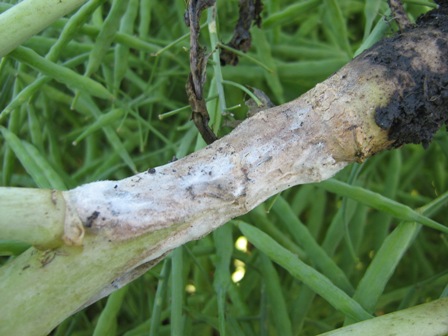
Sclerotinia Stem Rot
|
Harvesting Canola
Desiccation
Canola typically is not desiccated, since the pods shatter easily after desiccation. Desiccation accelerates plant dry-down, not plant maturity. For detailed information on desiccation, consult the Guide to Field Crop Protection.
Combining
Canola is considered ready to combine when moisture reaches 10% or less and minimal green seed can be found. Pickup speed should match ground speed to minimize shattering losses. Cylinder speed should be about 500-900 rpm. If the cylinder speed is too fast, seeds will crack. Wind speed should be kept low in order to minimize seed losses with the chaff.
Straw Management
Canola straw breaks down quite readily. In order to minimize seeding problems in the spring, the straw and chaff should be spread behind the combine rather than placed in a row.
Moisture
Canola is marketed at 10%. For long-term storage, canola should be at 8% to 9% moisture and below 20°C.
Storage
Once in storage, canola should be cooled since the seed continues a high respiration rate for up to six weeks. This respiration rate creates moist areas (sweating) in the bin that become hot spots. Once binned, canola should be monitored carefully for heating problems.
For specific information on:
- protecting canola export markets Canola Export Ready
- seed treatments and pesticide information, refer to the Guide to Field Crop Protection
- integrated management of weeds, crop pests and diseases, refer to the Field Scouting Guide
- optimizing fertilizer use, refer to the Soil Fertility Guide
- making varietal choices based on agronomic characteristics, refer to Seed Manitoba
Links:
For further information, contact your nearest Manitoba Agriculture office.

